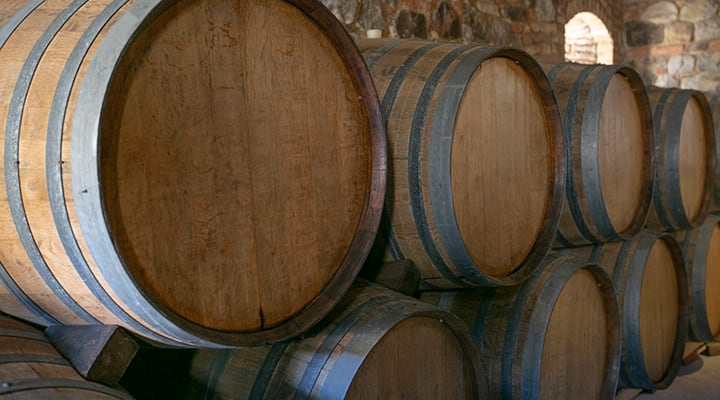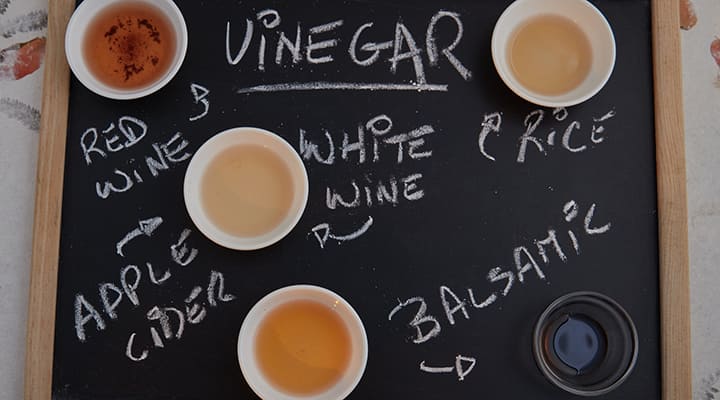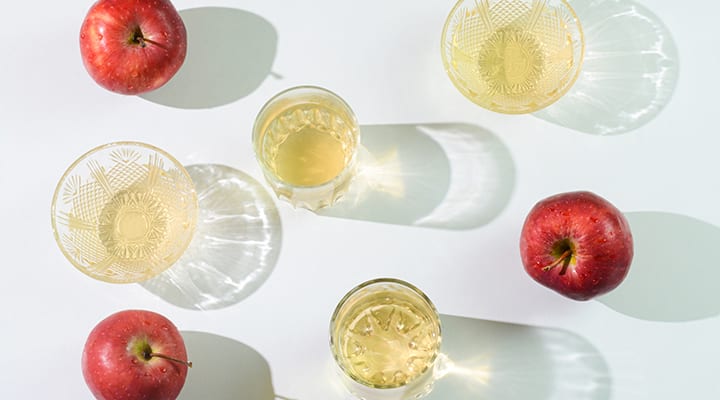
12 Types of Vinegar: What's the Difference?
Published: November 2023
One day, I opened my cabinet and discovered that I had seven types of vinegar on hand. This was kind of surprising to me! Go ahead and check your own pantry: chances are that you have at least a few varieties as well. In retrospect, though, my vinegar collection shouldn't have been much of a shock. From use in salad dressings to food preservation and pickling, vinegar is versatile; many also use it as a household cleaner! And if stored properly, it pretty much lasts forever(ish).
But does this eternal condiment benefit our health? For example: apple cider vinegar sure has gained some buzz in recent years, but does it live up to the hype? On one hand, vinegar is not a significant source of vitamins and minerals (although some varieties have small amounts of potassium). Yet researchers have found that vinegar may be beneficial, partly due to active compounds such as polyphenols and the acetic acid it contains. Some studies suggest vinegar can support already-healthy glucose levels.
And of course, pairing vinegar with other healthful foods, such as extra virgin olive oil and leafy greens like lettuce or spinach, makes this low-calorie liquid a condiment of choice for a well-rounded diet.
Let's take a deep dive into vinegar (not literally, of course!) and discuss how it's made, the 12 most popular varieties, and which types are the healthiest.
What is vinegar?
The word "vinegar" originates from the French translation "sour wine" since it can be made from the fermentation of red wine. But it can also be made from grains or other fruits aside from grapes, such as apples.
Vinegar is the result of a double fermentation process (quick food science lesson coming up!). First, the sugars from fruit or grains are converted to ethanol (alcohol) by yeast, and then from ethanol to acetic acid by Acetobacter bacteria. This process takes time, and the slower the fermentation, the more flavor and desirable characteristics develop.
The composition of vinegar is primarily water, followed by acetic acid (the type of acid found in vinegar), with small amounts of nutrients. The flavor of vinegar is influenced by the food source it is derived from and the percentage of acetic acid it contains. Acetic acid gives vinegar its signature sharp, slightly sour taste, with the fruit-derived types offering a touch of sweetness. Acid can make a more well-rounded dish and give new life to an old favorite.
12 most popular vinegars
There are 12 popular types of vinegar, many with specific regional and cultural ties. Let's explore the most commonly used varieties.
1. Balsamic vinegar
Balsamic vinegar is complex, sweet and tangy. Just how complex it is, however, depends on how it is made. The stuff you find at the grocery store is generally not going to be the same as Italian balsamic aged in wooden barrels for over a decade. A quality balsamic can be used in a lot of unique ways beyond your Caprese salad, such as on your steak or even vanilla ice cream! There are three main varieties of balsamic vinegar:
Mass-produced
: The most inexpensive option is mass-produced balsamic vinegar, which often contains additives such as thickening agents to try to mimic the consistency of traditionally made balsamic.Aceto Balsamico Tradizionale di Modena (or Reggio Emilia)
: Nicknamed "black gold," this type of balsamic is the real deal and can cost over $100 in the US. Why is it so pricy? Reggio Emilia is made by traditional methods which must meet a variety of criteria before it enters its hallmark tear-shaped bottle. The end result has no other ingredients or additives and is made from 100% grape must, which is a juice consisting of the grape skins and seeds and is also used in the first steps of winemaking. This type of balsamic is produced in specific regions of Italy where the unfermented grape juice is first cooked down into the consistency of a syrup, then undergoes fermentation. The vinegar is then aged in a series of progressively smaller barrels for at least 12 years. The wood adds aroma and complexity to the flavor. This distinct and time-consuming process is what lends to the high price point.Aceto Balsamico di Modena IGP
: Want something in between low- and high-grade balsamic? This option is also made in Italy and is a more affordable option that is comparable to the traditional type. There are also other mid-grade balsamic vinegars that follow a similar production method but are produced outside of Italy.
2. Rice vinegar
Rice vinegar is a staple in Japanese cuisine for sushi rice, marinating meat, making a cucumber salad, or for use in dipping sauces. Rice vinegar has a slightly lower percentage of acetic acid compared to other vinegars—about 4%. You may have also noticed that rice vinegar is a bit sweeter in taste than other options.
3. Red rice vinegar
You may have heard of red yeast rice extract before, which is used to support healthy cholesterol levels. Red rice vinegar is made from red yeast rice, which is white rice that gets its red color from fermentation with yeast. (Wait, does that mean red rice vinegar is actually the result of triple fermentation?!) Like regular rice vinegar, it is less acidic compared to other vinegars. It is most commonly used in Cantonese cuisine.
4. Black vinegar
This isn't the same thing as balsamic (which is also a dark color). Black vinegar is an umbrella term for grain-based vinegar, including rice, and is aged in clay pots, whereas balsamic vinegar comes from grapes fermented in barrels. The flavor of black vinegar depends on the source, but can be smoky and savory (umami), and is used in Asian cuisine for braises, sauces, and beyond.
5. Apple cider vinegar
Whole apples are crushed and pressed into apple juice then undergo the double fermentation process to form a vinegar after an intermediate hard cider. It works great as a salad dressing, to add a touch of sweetness to a BBQ sauce, in fall-inspired dishes, and some people even drink it straight up or as part of a beverage for its potential health benefits (more on this in the following section).
6. Malt vinegar
Malt vinegar is a grain-based vinegar typically made from barley, and the fermentation process includes ale (beer) instead of wine to make the final product. The flavor is sometimes described as nutty with hints of caramel. Have you seen it at a pub? Malt vinegar is especially popular in British cuisine where it is used in chutney and perhaps the most common way to eat it: with fish and chips since it pairs well with potatoes.
7. Red wine vinegar
Red wine vinegar is used to make mignonette sauce for oysters, dressings and more. If you are looking to go on a tasting journey and embrace your inner gastronaut, here is a pro tip: when shopping for red wine vinegar, you can follow a similar process as you would if you were shopping for red wine. That is: check to see if the types of grapes used to make the wine/vinegar are listed. If not, it is likely the result of a blend of grapes, so the flavor profile will not be as distinct.
Explore Our Best Glucose Management / Blood Sugar Supplements
8. White wine vinegar
Not to be confused with distilled white vinegar, white wine vinegar is made from white wine with a subtly fruity flavor profile. Many of us have enjoyed an eggs Benedict with hollandaise sauce at brunch, but did you know a classic hollandaise recipe calls for white wine vinegar? It is also found in another French sauce: beurre blanc.
9. Sherry vinegar
Sherry vinegar, or "vinagre de Jerez," which has a minimum of 7% acidity, carries regional designations like balsamic vinegar, but is produced in Spain. Sherry itself is a fortified wine (a wine with a distilled spirit added) made from white grapes grown in the Andalusia, Spain wine region and is fermented in oak barrels to make vinegar. Sherry vinegar is categorized by age and grape varieties. Each type of grape has its own distinctive qualities, producing vinegars that vary in color, taste, and composition: from light and sharp to dark and intense.
10. Champagne vinegar
While the quintessential celebratory bubbly itself must be from the Champagne, France region to be called champagne, champagne vinegar can be made in other parts of France, or elsewhere from sparkling wine. This delicate vinegar is used for drizzling, salad or uses similar to that of white wine vinegar.
11. Distilled white vinegar
Distilled white vinegar is made from grain alcohol and has at least 5% acidity. Though it can be used for non-cooking purposes, including an abundance of cleaning hacks (hello, fresh microwave and coffee maker), it's a good option for when you need vinegar's acid but not its flavor or color. This makes it a popular choice for pickling. But distilled white vinegar can also serve additional culinary purposes, including helping baked goods rise, or giving you a more uniform poached egg.
12. Coconut vinegar
Popular in Southern India and Southeast Asia, coconut vinegar comes from palm wine, or as locals call it, "toddy," which can be made from the sap of various palm trees. A popular sugar alternative, coconut sugar, is also derived from the sap of the coconut palm tree. If you aren't a big coconut flavor fan, you may still enjoy its slightly sweet, subtle coconut flavor. Coconut vinegar can be incorporated into dishes with other tropical foods, like mango, and used in curries, marinades and fish dishes.
Which vinegar is best for health?
Like the cloudiness of some vinegars, this answer isn't totally clear to researchers. Among vinegars, apple cider vinegar (ACV) is perhaps the most widely touted for its health benefits. Although it indeed shows promise for glucose and cholesterol management, more studies are needed to confirm these benefits. Plus, these benefits aren't necessarily exclusive to ACV.
The same active compounds, most notably acetic acid, can be found in other vinegars as well. All vinegars contain 4%-8% acetic acid. (Per FDA guidelines, vinegar needs to contain at least 4% acetic acid to be considered a vinegar.) Apple cider vinegar typically contains 5% acetic acid, which makes it mid-range in terms of acetic acid levels.
What about ACV that includes "the mother"? Some consider this unpasteurized (raw, unfiltered) apple cider vinegar particularly healthy because it's a source of beneficial bacteria. But this is also debatable. Although Acetobacter spp., the acetic acid bacteria known as the mother, have some probiotic characteristics, vinegar is not currently considered a probiotic food by the International Scientific Association for Probiotics and Prebiotics guidelines.
That doesn't necessarily mean vinegar is not beneficial to our health, and there are other ways the microbiome is involved. Gut microbes are able to ferment indigestible foods, such as dietary fibers, which yield short-chain fatty acids (SCFA) as end products that may confer beneficial metabolic effects. One of the most abundant SCFAs is acetate. Oral ingestion of vinegar rapidly increases circulating acetate as observed in healthy participants. An interesting area of research is the potential of probiotic interventions to increase microbial-derived acetate production in the gut and its effects on human metabolic health.
But before we get too excited about this, note that consuming a high-fiber diet has also been shown to increase acetic acid production through colonic fermentation. In fact, researchers aim to distinguish whether fiber or vinegar is responsible for beneficial outcomes that have been observed in studies.
What makes vinegar healthy?
Aside from acetic acid, researchers believe the health-supporting abilities of vinegars are mainly due to the presence of organic acids, polyphenols, and melanoidins, which are also present in coffee. Polyphenols from apple cider, grape, sherry, and balsamic vinegar such as gallic acid, catechins, quercetin and melanoidins provide antioxidants. It is important to consider the vinegar type since their composition of phenolic, flavonoid, and acetic acid content can differ.
It's been tricky, though, to pinpoint whether the benefits are specific to vinegar itself, or the nutrients in the foods that are used to make vinegar (grapes, apples, etc.). One strategy for future studies would be to use white vinegar to deliver acetic acid to participants since it has been distilled and won't contain other bioactive compounds.
Is vinegar good for healthy glucose levels?
Among the potential benefits of vinegar is the ability to support healthy blood sugar. Some of the mechanisms have been identified that this benefit can be attributed to is the acetic acid content, inhibition of α-amylase action (an enzyme that breaks down carbohydrates); increased glucose uptake; increased GLP-1 activity (a hormone), and mediation by transcription factors.
A 2021 meta-analysis including 16 studies involving 910 participants who consumed between 750 and 3,600 mg of acetic acid daily in interventions lasting an average of 8 weeks concluded that acetic acid has the potential to support healthy blood glucose and healthy triglyceride levels. However, a number of confounding factors were identified by the authors who recommend more high-quality studies evaluating a longer time frame. A 2019 clinical trial suggests that daily vinegar intake in amounts of ∼10-30 mL (∼2-6 tablespoons) appears to improve the glycemic response to carbohydrate-rich meals.
Should I take a vinegar supplement?
If you do choose to take a vinegar supplement, ensure the formula specifies its composition (e.g., acetic acid percentage, polyphenols, etc.) as standardization to active, beneficial compounds is key in the making of efficacious supplement formulas. If maintaining already-healthy glucose levels is your primary goal, take our blood sugar quiz to determine the best supplement for you.
References
- Chen H, et al. "Vinegar Functions on Health: Constituents, Sources, and Formation Mechanisms." Comprehensive Reviews in Food Science and Food Safety. September 2016. https://ift.onlinelibrary.wiley.com/doi/10.1111/1541-4337.12228
- Gheflati A, et al. "The effect of apple vinegar consumption on glycemic indices, blood pressure, oxidative stress, and homocysteine in patients with type 2 diabetes and dyslipidemia: A randomized controlled clinical trial." Clin Nutr ESPEN. October 2019. https://pubmed.ncbi.nlm.nih.gov/31451249/
- Ostman E, et al. "Vinegar supplementation lowers glucose and insulin responses and increases satiety after a bread meal in healthy subjects." Eur J Clin Nutr. September 2005. https://pubmed.ncbi.nlm.nih.gov/16015276/
- Safari MS, et al. "Investigating the antibacterial effects of some Lactobacillus, Bifidobacterium and acetobacter strains killed by different methods on Streptococcus mutans and Escherichia coli." Mol Biol Res Commun. September 2019. https://www.ncbi.nlm.nih.gov/pmc/articles/PMC6802690/
- Santos HO, et al. "Vinegar (acetic acid) intake on glucose metabolism: A narrative review." Clin Nutr ESPEN. August 2019. https://pubmed.ncbi.nlm.nih.gov/31221273/
- Valdes DS, et al. "Effect of Dietary Acetic Acid Supplementation on Plasma Glucose, Lipid Profiles, and Body Mass Index in Human Adults: A Systematic Review and Meta-analysis." Journal of the Academy of Nutrition and Dietetics. January 2021. https://www.jandonline.org/article/S2212-2672(20)31529-X/fulltext
- "Vinegar." Harvard School of Public Health. October 2019. https://www.hsph.harvard.edu/nutritionsource/food-features/vinegar/
Like what you read?
Please subscribe to get email updates on this blog.










